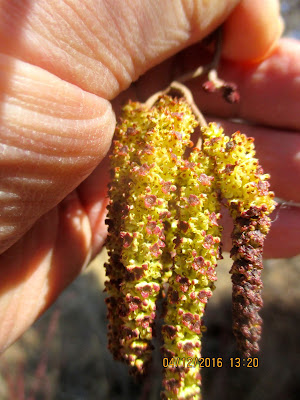 |
| MALE CATKINS SHEDDING POLLEN NOW... |
 |
| ...FEMALE FLOWERS IN BLOOM... |
 |
| ...WHILE LAST YEAR'S EMPTY SEED CONES STILL HANG ON... |
 |
| RED MAPLE (ACER RUBRUM) IS BLOOMING |
 |
| FIRST DAFFODILS BLOOMING ON SOUTH SIDE OF HOURS |
 |
| RELATIVELY LARGE, TOOTHED LEAF OF TAG ALDER (UW Herbarium photo) |
Sunday, 8:30 AM. 60 degrees F at the ferry dock, 58 on the back porch. Wind SW, calm with occasional light gusts. The sky is mostly overcast, the humidity 57% and the barometer more or less steady at 30.32". There is a chance of rain showers this morning.
It has become spring this morning, which I count as really here when the red maples flower (Acer rubrum, in the Maple Family, the Aceraceae}. Add to that the first daffodils, and it cannot be denied.
It has become spring this morning, which I count as really here when the red maples flower (Acer rubrum, in the Maple Family, the Aceraceae}. Add to that the first daffodils, and it cannot be denied.
Tag alder, or speckled alder, Alnus incana, is a common large, multiple stemmed shrub (occasionally small tree) of wet areas throughout most of North America except the South and the prairie states. It can occupy huge areas that have been cut over, particularly in the North (in my observation). It is called speckled because o the light colored lenticels that occur on its reddish, cherry-like bark. I do not know the derivation of the name "tag alder."
Alnus incana has several synonyms, including A. serrulata and A rugosa, and there are a number of other species of alder with which it hybridizes, particularly at the edges of its range, so I can't get too particular as to its exact botanical classification. Additionally, there is a larger European species, A glutinosa, which is occasionally used as a street tree. The alders have a light, useful wood but probably none but the European species becomes large enough to be milled. The genus also has considerable folk medicinal value, as all parts of the plant contain salicilates, and alder bark was used in kinnikinick, the American Indian smoking mixture.
Alders are nitrogen fixing plants, and are important in preparing mountain soils for forestation; they are intolerant to heavy shade and thus are a natural nurse crop for Douglas fir and other forest trees, which shade the alders out as they grow. Like many people, tag alders don't seem very useful or important until we really get to know them.
Spring is "ziigwan" in the language of our Ojibway neighbors, and it rather snuck up on us.
Alnus incana has several synonyms, including A. serrulata and A rugosa, and there are a number of other species of alder with which it hybridizes, particularly at the edges of its range, so I can't get too particular as to its exact botanical classification. Additionally, there is a larger European species, A glutinosa, which is occasionally used as a street tree. The alders have a light, useful wood but probably none but the European species becomes large enough to be milled. The genus also has considerable folk medicinal value, as all parts of the plant contain salicilates, and alder bark was used in kinnikinick, the American Indian smoking mixture.
Alders are nitrogen fixing plants, and are important in preparing mountain soils for forestation; they are intolerant to heavy shade and thus are a natural nurse crop for Douglas fir and other forest trees, which shade the alders out as they grow. Like many people, tag alders don't seem very useful or important until we really get to know them.
Spring is "ziigwan" in the language of our Ojibway neighbors, and it rather snuck up on us.











No comments:
Post a Comment